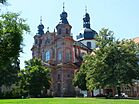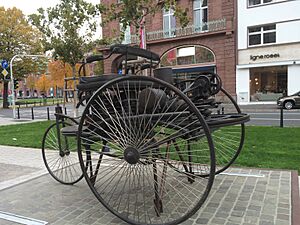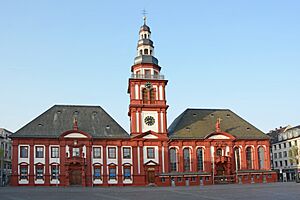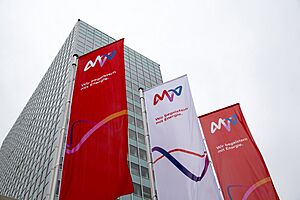Mannheim facts for kids
Quick facts for kids
Mannheim
Mannem / Monnem (Palatine German)
|
|||
|---|---|---|---|
|
Clockwise from top: Friedrichsplatz; Luisenpark; Augustaanlage; Mannheim Palace; Mannheim Water Tower; and Jesuit Church
|
|||
|
|||
| Country | Germany | ||
| State | Baden-Württemberg | ||
| Admin. region | Karlsruhe | ||
| District | Urban district | ||
| Founded | 1607 | ||
| Subdivisions | 17 Stadtbezirke | ||
| Area | |||
| • City | 144.96 km2 (55.97 sq mi) | ||
| Elevation | 97 m (318 ft) | ||
| Population
(2022-12-31)
|
|||
| • City | 315,554 | ||
| • Density | 2,176.83/km2 (5,637.98/sq mi) | ||
| • Metro | 2,362,046 (2,012) | ||
| Demonym(s) | Mannheimer | ||
| Time zone | UTC+01:00 (CET) | ||
| • Summer (DST) | UTC+02:00 (CEST) | ||
| Postal codes |
68001–68309
|
||
| Dialling codes | 0621 | ||
| Vehicle registration | MA | ||
| Website | www.mannheim.de | ||
Mannheim is a big city in the German state of Baden-Württemberg. It is the second-largest city there, after Stuttgart. In 2021, about 311,831 people lived in Mannheim. The city is an important center for culture and business in the Rhine-Neckar Metropolitan Region. This region is home to nearly 2.4 million people.
Mannheim is located where the Rhine and Neckar rivers meet. This area is known as the Upper Rhine Plain, which is one of Germany's warmest places. Mannheim is special because it borders two other German states: Rhineland-Palatinate and Hesse. It forms a large city area with Ludwigshafen am Rhein across the Rhine.
The city center of Mannheim is unique. Its streets are laid out in a grid pattern, like a checkerboard. This is why it's called Quadratestadt, meaning "Square City". Instead of street names, the blocks are numbered from A1 to U6. At the bottom of this grid is Mannheim Palace. It is one of the biggest palace complexes in the world. Today, it houses the University of Mannheim, a top school for business.
Mannheim is also famous for its inventions. The automobile, the bicycle, and the tractor were all invented here! Because of this, Mannheim is often called the "city of inventions". The city is a major hub for transportation. It has a big train station, a large train sorting yard, and Germany's biggest inland port. Many big companies like Roche and Siemens have offices or factories here. Mannheim is also a UNESCO City of Music.
Contents
History
Early Beginnings
People have lived in the Mannheim area since Roman times. The city's name, Mannenheim, was first written down in 766 AD. For a long time, Mannheim was just a small village.
Building the City
In 1606, Frederick IV, Elector Palatine, started building a fortress called Friedrichsburg. He also planned the city center with its grid of streets. In 1607, Mannheim was officially given the status of a "city".
However, Mannheim faced many challenges. It was almost completely destroyed in the Thirty Years' War around 1622. Then, it was badly damaged again by the French army in 1689 during the Nine Years' War.
After being rebuilt, Mannheim became the capital of the Electorate of the Palatinate in 1720. This is when Mannheim Palace and the Jesuit Church were built. They were finished in 1760.
Changes and Inventions
In the 1700s, Mannheim was known for its classical music. It had one of the best court orchestras in Europe. In 1802, Mannheim became part of the Grand Duchy of Baden.
A big climate problem in 1816-17 caused a lot of hardship. During this time, Karl Drais invented the first bicycle in 1817. This was a very important invention!
In 1828, the Rhine Harbour was built. The first railway in Baden opened from Mannheim to Heidelberg in 1840. These improvements helped Mannheim grow.
In 1865, Friedrich Engelhorn started the BASF company in Mannheim. It grew into the world's largest chemical company. In 1886, Karl Benz invented the first automobile here. His wife, Bertha Benz, took the world's first long-distance car trip from Mannheim in 1888.
20th Century and Wars
During World War I, Mannheim's factories were important for Germany's war efforts. This made the city a target for air raids.
After World War I, the Heinrich Lanz Company built the Bulldog, a popular tractor. In 1923, Benz & Cie. developed the world's first compact diesel-powered car in Mannheim. By 1930, Mannheim and its neighbor Ludwigshafen had a population of 385,000.
During World War II, Mannheim's city center was almost completely destroyed by air raids. Many buildings were lost, and thousands of people were affected. After the war, the city began to rebuild.
Modern Mannheim
After World War II, Mannheim was rebuilt. Important buildings like Mannheim Palace and the Mannheim Water Tower were restored. The University of Mannheim was founded in 1967.
In 1975, Mannheim hosted the Bundesgartenschau (Federal Horticulture Show). For this event, new buildings were constructed, like the telecommunications tower.
In the 1980s and 1990s, more big projects were completed. These included a planetarium, an art gallery extension, and the State Museum for Technology and Work. Mannheim has changed from a city mainly focused on factories to one with many different types of jobs.
In 2007, Mannheim celebrated its 400th anniversary. The city continues to grow and develop. In 2023, Mannheim hosted the Bundesgartenschau again.
Geography
Climate
| Climate data for Mannheim (1991–2020 normals) | |||||||||||||
|---|---|---|---|---|---|---|---|---|---|---|---|---|---|
| Month | Jan | Feb | Mar | Apr | May | Jun | Jul | Aug | Sep | Oct | Nov | Dec | Year |
| Record high °C (°F) | 16.4 (61.5) |
20.2 (68.4) |
26.1 (79.0) |
32.0 (89.6) |
33.2 (91.8) |
38.9 (102.0) |
39.0 (102.2) |
39.8 (103.6) |
34.3 (93.7) |
28.5 (83.3) |
22.6 (72.7) |
17.5 (63.5) |
39.8 (103.6) |
| Mean daily maximum °C (°F) | 5.3 (41.5) |
7.3 (45.1) |
12.2 (54.0) |
17.2 (63.0) |
21.0 (69.8) |
24.5 (76.1) |
26.7 (80.1) |
26.5 (79.7) |
21.6 (70.9) |
15.5 (59.9) |
9.3 (48.7) |
5.9 (42.6) |
16.1 (61.0) |
| Daily mean °C (°F) | 2.4 (36.3) |
3.3 (37.9) |
7.1 (44.8) |
11.3 (52.3) |
15.3 (59.5) |
18.8 (65.8) |
20.7 (69.3) |
20.3 (68.5) |
15.8 (60.4) |
10.9 (51.6) |
6.2 (43.2) |
3.3 (37.9) |
11.3 (52.3) |
| Mean daily minimum °C (°F) | −0.7 (30.7) |
−0.5 (31.1) |
2.1 (35.8) |
5.1 (41.2) |
9.2 (48.6) |
12.7 (54.9) |
14.6 (58.3) |
14.4 (57.9) |
10.6 (51.1) |
6.7 (44.1) |
2.8 (37.0) |
0.4 (32.7) |
6.5 (43.7) |
| Record low °C (°F) | −18.7 (−1.7) |
−21.1 (−6.0) |
−13.6 (7.5) |
−6.4 (20.5) |
−0.1 (31.8) |
4.0 (39.2) |
4.7 (40.5) |
5.3 (41.5) |
2.5 (36.5) |
−5.0 (23.0) |
−8.7 (16.3) |
−18.3 (−0.9) |
−21.1 (−6.0) |
| Average precipitation mm (inches) | 41.9 (1.65) |
40.6 (1.60) |
42.3 (1.67) |
40.5 (1.59) |
67.6 (2.66) |
63.8 (2.51) |
71.2 (2.80) |
61.7 (2.43) |
50.0 (1.97) |
53.0 (2.09) |
52.9 (2.08) |
55.0 (2.17) |
640.5 (25.22) |
| Average precipitation days (≥ 1.0 mm) | 15.1 | 13.9 | 13.5 | 12.0 | 14.4 | 13.0 | 14.4 | 13.5 | 11.8 | 13.8 | 15.5 | 17.2 | 168.3 |
| Average snowy days (≥ 1.0 cm) | 5.7 | 3.1 | 1.0 | 0 | 0 | 0 | 0 | 0 | 0 | 0 | 0.6 | 3.0 | 13.4 |
| Average relative humidity (%) | 82.4 | 77.8 | 70.7 | 64.8 | 67.0 | 66.0 | 65.2 | 66.6 | 72.9 | 81.3 | 85.4 | 84.9 | 73.7 |
| Mean monthly sunshine hours | 56.0 | 82.1 | 135.9 | 190.8 | 216.9 | 225.6 | 235.6 | 224.2 | 169.7 | 108.1 | 56.1 | 44.1 | 1,733.7 |
| Source 1: World Meteorological Organization | |||||||||||||
| Source 2: Data derived from Deutscher Wetterdienst | |||||||||||||
| Climate data for Mannheim 2019–present | |||||||||||||
|---|---|---|---|---|---|---|---|---|---|---|---|---|---|
| Month | Jan | Feb | Mar | Apr | May | Jun | Jul | Aug | Sep | Oct | Nov | Dec | Year |
| Mean daily maximum °C (°F) | 7.2 (45.0) |
11.3 (52.3) |
13.0 (55.4) |
19.1 (66.4) |
19.3 (66.7) |
25.9 (78.6) |
27.5 (81.5) |
27.6 (81.7) |
21.4 (70.5) |
16.6 (61.9) |
8.7 (47.7) |
7.6 (45.7) |
17.1 (62.8) |
| Daily mean °C (°F) | 4.4 (39.9) |
6.1 (43.0) |
8.2 (46.8) |
12.3 (54.1) |
13.7 (56.7) |
19.9 (67.8) |
21.0 (69.8) |
20.9 (69.6) |
16.0 (60.8) |
12.6 (54.7) |
6.0 (42.8) |
4.8 (40.6) |
12.2 (53.9) |
| Mean daily minimum °C (°F) | 1.0 (33.8) |
1.6 (34.9) |
3.1 (37.6) |
4.8 (40.6) |
7.0 (44.6) |
12.9 (55.2) |
13.8 (56.8) |
14.8 (58.6) |
10.2 (50.4) |
9.0 (48.2) |
3.0 (37.4) |
1.9 (35.4) |
6.9 (44.5) |
| Average precipitation mm (inches) | 15.6 (0.61) |
49.3 (1.94) |
35.7 (1.41) |
22.6 (0.89) |
55.4 (2.18) |
81.4 (3.20) |
38.3 (1.51) |
63.3 (2.49) |
77.1 (3.04) |
89.9 (3.54) |
48.6 (1.91) |
52.3 (2.06) |
629.5 (24.78) |
| Average snowfall cm (inches) | 4.0 (1.6) |
1.6 (0.6) |
1.2 (0.5) |
0 (0) |
0 (0) |
0 (0) |
0 (0) |
0 (0) |
0 (0) |
1.0 (0.4) |
2.0 (0.8) |
5.6 (2.2) |
2.6 (1.0) |
| Mean monthly sunshine hours | 57.3 | 116.2 | 164.0 | 251.2 | 247.9 | 268.1 | 286.1 | 248.9 | 199.1 | 97.5 | 38.2 | 53.4 | 2,027.9 |
| Source: Deutscher Wetterdienst | |||||||||||||
Mannheim is in one of Germany's warmest areas. In summer, temperatures can reach 35°C (95°F) or higher. The highest temperature ever recorded was 39.8°C (103.6°F). Even at night, it can stay warm.
Compared to other parts of Germany, Mannheim has more humidity in summer. Snow is not very common in winter. Most rain falls during afternoon thunderstorms in the warmer months. The climate here is generally mild, with enough rain all year.
Demographics
Population Growth
| Historical population | ||
|---|---|---|
| Year | Pop. | ±% |
| 1450 | 570 | — |
| 1663 | 3,000 | +426.3% |
| 1729 | 15,760 | +425.3% |
| 1777 | 25,353 | +60.9% |
| 1802 | 18,818 | −25.8% |
| 1852 | 24,316 | +29.2% |
| 1871 | 39,606 | +62.9% |
| 1890 | 79,058 | +99.6% |
| 1895 | 97,780 | +23.7% |
| 1900 | 141,131 | +44.3% |
| 1919 | 229,576 | +62.7% |
| 1925 | 247,486 | +7.8% |
| 1933 | 275,162 | +11.2% |
| 1939 | 284,957 | +3.6% |
| 1945 | 186,310 | −34.6% |
| 1950 | 245,634 | +31.8% |
| 1956 | 287,210 | +16.9% |
| 1961 | 313,890 | +9.3% |
| 1966 | 329,301 | +4.9% |
| 1971 | 332,378 | +0.9% |
| 1976 | 309,059 | −7.0% |
| 1981 | 304,219 | −1.6% |
| 1986 | 294,648 | −3.1% |
| 1990 | 310,411 | +5.3% |
| 2001 | 308,385 | −0.7% |
| 2011 | 290,117 | −5.9% |
| 2022 | 313,693 | +8.1% |
| Population size may be affected by changes in administrative divisions. | ||
Mannheim has about 315,000 people. It is the second-largest city in Baden-Württemberg. Mannheim became a major city in the early 1800s because of its growing industries. Its location by the Rhine and Neckar rivers made it a good place for factories.
After World War II, Mannheim was heavily damaged. But it quickly rebuilt and became a big industrial city again. In the 1950s, many motor, electronic, and power plant companies came to Mannheim. This made the population grow fast. In recent years, the city's university has attracted many students. This makes Mannheim a popular university city in Germany.
People from Around the World
Many people from different countries live in Mannheim. About 44.7% of all people in Mannheim have foreign backgrounds. The Neckarstadt-West area has the most foreign residents. Wallstadt has the fewest. A large number of immigrants come from the Balkans and other European countries.
| Rank | Nationality | Population (31 December 2022) |
|---|---|---|
| 1 | Turkey | 15,779 (5.12%) |
| 2 | Italy | 8,165 (2.65%) |
| 3 | Bulgaria | 6,997 (2.27%) |
| 4 | Poland | 6,595 (2.14%) |
| 5 | Romania | 5,663 (1.83%) |
| 6 | Croatia | 4,565 (1.48%) |
| 7 | Ukraine | 4,207 (1.32%) |
| 8 | Greece | 3,341 (1.08%) |
| 9 | Spain | 1,754 (0.56%) |
| 10 | Bosnia and Herzegovina | 1,680 (0.54%) |
| 11 | Syria | 1,642 (0.53%) |
| 12 | India | 1,541 (0.5%) |
| 13 | Hungary | 1,341 (0.43%) |
| 14 | France | 1,266 (0.41%) |
| 15 | Kosovo | 1,164 (0.37%) |
Religion
As of 2020, about 25.4% of Mannheim's population is Roman Catholic. About 20.0% are Protestant. The remaining 54.6% belong to other religions or have no religious affiliation.
Culture
Theatre
The National Theatre Mannheim was founded in 1779. It is the oldest "Stage" in Germany. In 1782, the famous play Die Räuber by Friedrich Schiller was first performed here.
Today, Mannheim also has many smaller theaters. These include the Oststadt-Theater and the TIG7.
Sport
Mannheim has two well-known football (soccer) clubs. SV Waldhof Mannheim plays in the third German league. VfR Mannheim won the German championship in 1949.
The Adler Mannheim (meaning "Mannheim Eagles") are a professional ice hockey team. They have won the German championship eight times.
The city is also home to the Mannheim Tornados. This is Germany's oldest baseball and softball club. They have won the championship 11 times.
The American football club Mannheim Bandits was started in 2003. They play in the top German Football League.
Rhein-Neckar Löwen is a professional handball team. They play in the German Handball League.
Mannheim has also hosted big sports events. These include the European Show Jumping Championships in 1997 and 2007.
Inventions
Mannheim is known for its many inventions. Forbes magazine even ranked it among the most inventive cities worldwide!
Here are some important inventions made in Mannheim:
- In 1817, Karl Drais built the first two-wheeled draisine. This was an early version of the bicycle.
- In 1886, Karl Benz drove the first automobile on the streets of Mannheim. This three-wheeled vehicle was powered by a gasoline engine. It is seen as the first car with an internal combustion engine.
- Karl Benz's wife, Bertha Benz, took the world's first long-distance car trip in August 1888. She drove from Mannheim to Pforzheim and back.
- The Lanz Bulldog, a popular tractor with a simple diesel engine, was introduced in 1921.
- In 1923, Karl Benz developed the world's first compact diesel-powered car in Mannheim.
- Julius Hatry built the world's first rocket plane in 1929.
- In 1969, Dario Fontanella invented the first Spaghettieis (spaghetti ice cream).
-
The world's first bicycle, built in Mannheim by Karl Freiherr von Drais in 1817
Education
The University of Mannheim is a leading university in Germany. It is especially strong in business and economics. The university is located in the beautiful Mannheim Palace. It attracts students from all over the world. More than 12,000 students were enrolled in 2013/14.
Mannheim also has other important schools. These include a medical school of Heidelberg University. There are also several music and theater academies, like the Pop Academy Mannheim. These schools bring many different students to the city.
Main Sights
Mannheim has many interesting places to visit:
- Fernmeldeturm Mannheim – A tall telecommunication tower, a landmark of the city.
- Synagoge (Mannheim) – The city's synagogue, built after World War II.
- Yavuz Sultan Selim Mosque – A beautiful mosque in Mannheim.
- Luisenpark – Named one of Europe's most beautiful parks. It has about 1.2 million visitors each year.
- Mannheim Palace (Mannheimer Schloss) – The city's castle and the main building of the University of Mannheim.
- Wasserturm – The city's landmark water tower.
- Jesuit Church – A grand church in the city.
- SAP Arena – A large indoor stadium. It is home to Mannheim's ice hockey team, the "Die Adler" (The Eagles).
- Breite Strasse, Kunststrasse, and Kapuzinerplanken – Mannheim's main shopping areas.
- Kunsthalle Mannheim – A museum of modern and contemporary art.
- Technoseum – A museum about technology.
- Multihalle – A unique multi-purpose hall. It is the world's largest self-supporting wooden lattice-shell building.
- The city center – Famous for its grid pattern of squares.
- Reiß-Engelhorn-Museen – A museum with many exhibits on archaeology, world cultures, and history.
- Maimarkt – The biggest regional trade fair in Germany.
- Marktplatz (Market square) – A farmers' market is held here every Tuesday, Thursday, and Saturday. You can find fresh fruits, vegetables, and flowers.
- Mannheimer Mess (Mannheim Fair) – A big fair that happens twice a year.
Economy
Mannheim is a very important business location in Germany. It is considered the economic center of the Rhine-Neckar Metropolitan Region. This region is one of Germany's most important business areas.
New Economy Magazine chose Mannheim as one of the top 20 cities that show what the world of tomorrow will be like. This is because of Mannheim's strong economy and new ideas.
Many large companies have factories, offices, or headquarters in Mannheim. These include Roche, ABB, IBM, Alstom, Unilever, and Siemens. The University Hospital Mannheim provides healthcare for the people of Mannheim and the surrounding region.
MVV Energie, based in Mannheim, is Germany's largest city-owned energy supplier.
Media
Mannheim has its own local daily newspaper, Mannheimer Morgen. Other newspapers like Die Rheinpfalz and Rhein-Neckar-Zeitung also have local sections for Mannheim. There are also weekly and bi-weekly papers that share local news.
Transport
Roads
The Mannheim area is surrounded by major highways. These roads connect it to big cities like Frankfurt in the north, Karlsruhe in the south, and Nuremberg in the east.
Trains
Mannheim Hauptbahnhof (central station) is a very important train hub in southwestern Germany. High-speed trains, called ICE, connect Mannheim to many major German cities.
River Transport
Mannheim Harbour is the second-largest river port in Germany. It covers a huge area. In 2016, 6.9 million tons of goods were moved through the port by water. About 500 companies, with 20,000 employees, are located in the Mannheim Harbour area.
Air Travel
Frankfurt International Airport is only 65 km (40 miles) north of Mannheim. Mannheim also has its own airport, Mannheim City Airport (MHG). Currently, there are commercial passenger flights from Mannheim to Sylt.
Local Public Transport
Local transport in Mannheim includes the RheinNeckar S-Bahn (a regional train system), eleven tram lines, and many bus lines. These are run by a company called Rhein-Neckar-Verkehr (RNV).
The RheinNeckar S-Bahn connects most of the Rhine-Neckar area. All S-Bahn lines go through Mannheim Hauptbahnhof. The tram network also connects Mannheim to Heidelberg. All public transport uses the same ticket prices set by the Verkehrsverbund Rhein-Neckar (VRN).
Block Numbering in the City Center
The city center of Mannheim has a very special way of numbering its blocks. Instead of street names and house numbers, each block has a code. For example, C3, 17 means block C3, building 17. This system has been used for centuries. It comes from how the city center was first planned as a fort.
The streets themselves don't have names. The block codes are arranged in a simple pattern. For example, C3 is between C2 and C4 in one direction. A street called Breite Straße runs through the middle of the blocks. Blocks A-K are on the west side, and L-U are on the east. House numbers start at the south corner of each block and go around.
This unique system can sometimes make it tricky to find an address using regular maps. It's often easier to ask for directions or look at one of the public maps around the city.
Twin Towns – Sister Cities
Mannheim has "sister city" relationships with other cities around the world. This helps them share culture and ideas.
- Swansea, Wales, United Kingdom (1957)
- Toulon, France (1959)
- Charlottenburg-Wilmersdorf (Berlin), Germany (1961)
- Windsor, Canada (1980)
- Riesa, Germany (1988)
- Chișinău, Moldova (1989)
- Bydgoszcz, Poland (1991)
- Klaipėda, Lithuania (2002)
- Zhenjiang, China (2004)
- Haifa, Israel (2009)
- Qingdao, China (2016)
- Chernivtsi, Ukraine (2022)
Notable People
Many famous people have come from Mannheim:
- Johann Baptist Cramer (1771–1858), a pianist and composer.
- Friedrich Engelhorn (1821–1902), who founded the BASF company.
- Carl Benz (1844–1929), the inventor of the first practical motorcar.
- Sepp Herberger (1897–1977), a famous football player and manager.
- Julius Hatry (1906–2000), who built the world's first rocket plane.
- Samuel Hans Adler (born 1928), a German-American composer.
- Rudi Altig (1937–2016), a well-known cyclist.
- Steffi Graf (born 1969), a famous tennis player.
- Xavier Naidoo (born 1971), a popular pop singer.
- Bülent Ceylan (born 1976), a German-Turkish comedian.
- Jochen Hecht (born 1977), an ice hockey player.
- Uwe Gensheimer (born 1989), a handball player.
- Giulia Enders (born 1990), a writer and medical researcher.
- Pascal Groß (born 1991), a footballer.
- Hakan Çalhanoğlu (born 1994), a Turkish footballer.
Images for kids
See also
 In Spanish: Mannheim para niños
In Spanish: Mannheim para niños
































